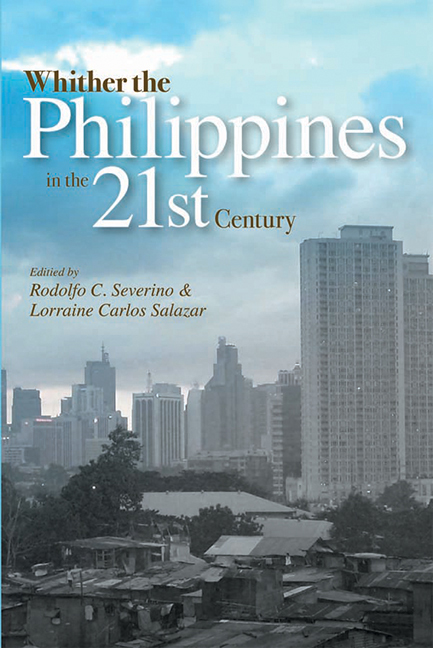Book contents
- Frontmatter
- Contents
- List of Illustrations
- Foreword
- Acknowledgements
- The Contributors
- List of Abbreviations
- Map of Southeast Asia
- 1 The Philippines in Southeast Asia
- 2 From Regime Crisis to System Change
- 3 Proposed Constitutional Reforms for Good Governance and Nation Building
- 4 The Military in Philippine Politics
- 5 Religion and Politics
- 6 The Philippine Press
- 7 Macroeconomic Issues and Challenges
- 8 Investment Climate and Business Opportunities
- 9 Why Does Poverty Persist in the Philippines?
- 10 Diaspora, Remittances, and Poverty
- 11 The Philippine Development Record
- 12 Sancho Panza in Buliok Complex
- 13 The Insurgency That Would Not Go Away
- 14 Whither the Philippines in the 21st Century?
- Index
7 - Macroeconomic Issues and Challenges
Published online by Cambridge University Press: 21 October 2015
- Frontmatter
- Contents
- List of Illustrations
- Foreword
- Acknowledgements
- The Contributors
- List of Abbreviations
- Map of Southeast Asia
- 1 The Philippines in Southeast Asia
- 2 From Regime Crisis to System Change
- 3 Proposed Constitutional Reforms for Good Governance and Nation Building
- 4 The Military in Philippine Politics
- 5 Religion and Politics
- 6 The Philippine Press
- 7 Macroeconomic Issues and Challenges
- 8 Investment Climate and Business Opportunities
- 9 Why Does Poverty Persist in the Philippines?
- 10 Diaspora, Remittances, and Poverty
- 11 The Philippine Development Record
- 12 Sancho Panza in Buliok Complex
- 13 The Insurgency That Would Not Go Away
- 14 Whither the Philippines in the 21st Century?
- Index
Summary
INTRODUCTION: MACROECONOMIC AND STRUCTURAL PROBLEMS*
This chapter reviews some macroeconomic issues relating to the current Philippine economy. To provide a proper understanding of these issues, their link will be associated with their structural underpinnings. Persistent macroeconomic problems often require a policy adjustment, and inevitably, assessment of the problems boils down to an understanding of what gets done, what gets delayed or what is not possible to do under the circumstances. A further device in presenting the issues is through a comparison with the experience of other East Asian and high-growth countries, which include some ASEAN countries.
The review follows this sequence. First, the recent growth performance of the economy is discussed. Then, the compositions of aggregate demand and of aggregate supply are described, emphasizing the reasons for the observed changes and trends. Next, the economy's saving and investment issues are highlighted, paying notice to the large gap between saving and investment. After that, the spotlight moves to the fiscal front that is a major contributor to the country's low saving rate. The fiscal sector is discussed in terms of dealing with deficit reduction and managing the public debt. Finally, the review expounds on the economy's external trade and payments position. Current problems and new opportunities are discussed in the context of globalization and the country's open stance.
A major theme that arises from this discussion is that the potentials for development in the Philippines are not fully exploited. A relative measure of this under-performance can be derived from the immense turnaround of economic prospects in 2006 just as soon as the government was able to deal with a reform on the fiscal front. A result of these measures led to higher tax revenues being earned, thereby braking a deteriorating fiscal situation. A lot of other benefits affecting macroeconomic fundamentals were likewise experienced, changing the dynamics of political and economic discourse.
- Type
- Chapter
- Information
- Whither the Philippines in the 21st Century? , pp. 142 - 179Publisher: ISEAS–Yusof Ishak InstitutePrint publication year: 2007

